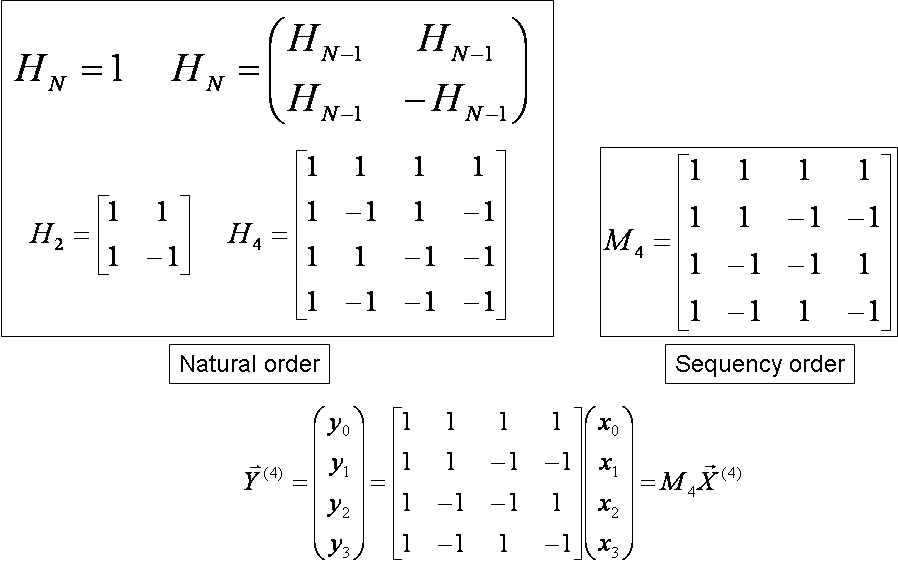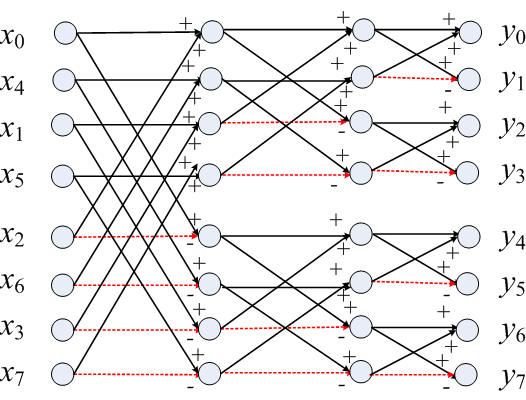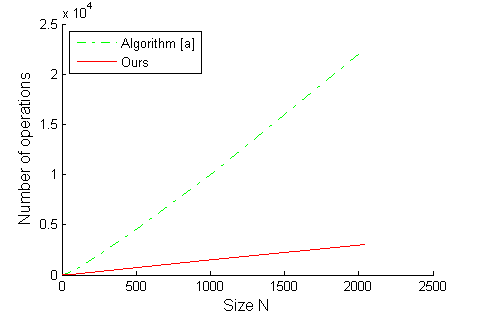Fast algorithm for Walsh Hadamard
transform on sliding windows Wanli Ouyang and Wai-Kuen Cham
Abstract ��This
paper proposes a fast algorithm for Walsh Hadamard
Transform on sliding windows which can be used to implement pattern matching
most efficiently. The computational requirement of the proposed algorithm is
about 1.5 additions per projection vector per sample, which is the lowest among
existing fast algorithms for Walsh Hadamard Transform
on sliding windows.
This webpage introduces
the fast Walsh Hadamard transform algorithm of the
following paper: Wanli Ouyang and Wai-Kuen
Cham, "Fast algorithm for Walsh Hadamard
transform on sliding windows", IEEE Trans. Pattern Analysis and machine
Intelligence , 32(1):165-171, Jan. 2010. [Full text
* ] [Powerpoint
]
* Personal use of
these materials is permitted . However,
permission to reprint/republish this material for advertising or promotional
purposes or for creating new collective works for resale or redistribution to
servers or lists, or to reuse any copyrighted component of this work in other
works must be obtained from IEEE.
Introduction
(from Wikipedia
The Walsh Hadamard transform (WHT) , also known as the Hadamard transform , Hadamard -Rademacher -Walsh transform ,
Walsh transform , or Walsh-Fourier
transform , is an example of a generalized class of Fourier transforms French mathematician Jacques Solomon
Hadamard Hans Adolph Rademacher Joseph Leonard Walsh orthogonal symmetric involutional linear operation 2m
real numbers complex numbers Hadamard matrices themselves are purely real).
The Hadamard transform HN is a
2m m Hadamard matrix N =2m m
Fig. 1 WHT in natural order and sequency order.
Application of WHT
In computer vision, it is used in pattern matching,
road/path tracking , mouth tracking , wide baseline
image matching, scene labeling, texture synthesis and augmented reality.
WHT is also used in data encryption signal processing data compression algorithms HD Photo MPEG-4 AVC video compression sum of absolute transformed differences
WHT is used in Quantum computation.
As pointed out in Wikipedia quantum algorithms Hadamard
transform as an initial step.
The N log ( N ) fast WHT algorithm
Naive implementation
of the WHT would have a computational complexity O( N 2 ) N logN
Fig. 2 The
fast Walsh Hadamard transform
applied to a vector of length 8 (From Wikipedia .
The 1.5N -1 fast WHT algorithm -- This paper
This paper
proposes a fast algorithm for Walsh Hadamard
Transform on sliding windows which can be used to implement pattern matching
most efficiently. The computational requirement of the proposed algorithm is
about 1.5 additions per projection vector per sample. The proposed algorithm
requires 1.5N-1 additions for transforming N numbers into N real
numbers. A comparison of our proposed algorithm and the algorithm in [a] is
shown in Fig. 3.
Other famous
WHT algorithms on sliding windows are in [b][ c]. In
[d], we propose a new transform and its fast algorithm.
Fig. 3 The
number of operations as a function of the WHT transform size N for the
algorithm in [a] and our algorithm.
New paper is here N additions for WHT.
Experimental results (where is my cup?)
The proposed fast WHT algorithm is utilized for pattern
matching. The algorithm finds out the same result as Full search (exhaustive
search) and significantly saves the computation required.
In the following video (enable ActiveX control to see the
video), pattern matching the proposed algorithm requires lees
than 0.1 second to locate the cup using pattern matching. The experiment
considers image without noise and image with Gassian
noise, Image blur and JPEG compression disturbances. This algorithm
guarantees to find the global optimum in pattern matching application.
��
ACKNOWLEDGMENTS
Many introduction of WHT and fast
WHT algorithm in this webpage are directly copied from Wikipedia
��
Reference
[a ] Fino , B.J., and Algazi , V.R., 1976, "Unified Matrix
Treatment of the
Fast Walsh-Hadamard Transform," IEEE
Transactions on Computers 25 : 1142-1146.
[b] Y. Hel-Or
and H. Hel-Or, "Real Time Pattern Matching Using Projection Kernels,"
IEEE Trans. Pattern Analysis and Machine Intelligence , vol. 27, no. 9, pp.
1430-1445, Sept. 2005.
[c] G. Ben-Artzi , H. Hel-Or, and Y. Hel-Or, "The Gray-Code Filter
Kernels," IEEE Trans. Pattern Analysis and Machine Intelligence ,
vol. 29, no. 3, pp. 382-393, Mar. 2007.
[d] Wanli Ouyang , Renqi
Zhang and Wai-Kuen Cham,
"Fast pattern matching using orthogonal Haar
transform ", In Proc. IEEE CVPR 2010 , Webpage and
source code
[e] Wanli Ouyang , Federico Tombari ,
Stefano Mattoccia , Luigi Di Stefano, and Wai - Kuen Cham, " Performance
Evaluation of Full Search Equivalent Pattern Matching Algorithms , " IEEE Trans. Pattern Anal.
Mach. Intell ., 34(1):127-143, Jan. 2012. Webpage and
source code
[f ] Wanli
Ouyang and Wai-Kuen
Cham, " Segmented
Gray-Code Kernels for Fast Pattern Matching " , IEEE Trans. Image Processing,
22(4):1512-1525, Apr. 2013. Webpage and source
code
Source code
Matlab code is available here
Please note
the "Conditions of Use and Disclaimer" below for this code.
Conditions of
Use and Disclaimer: express or implied,
including but not limited: Shatin , N.T., Hong Kong


